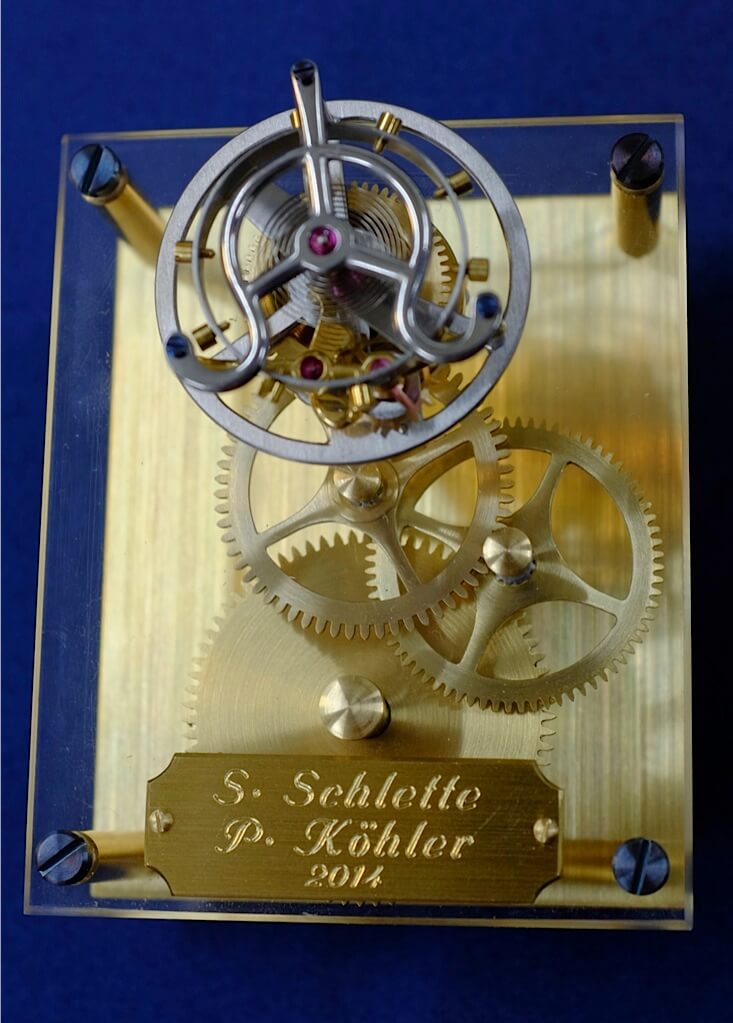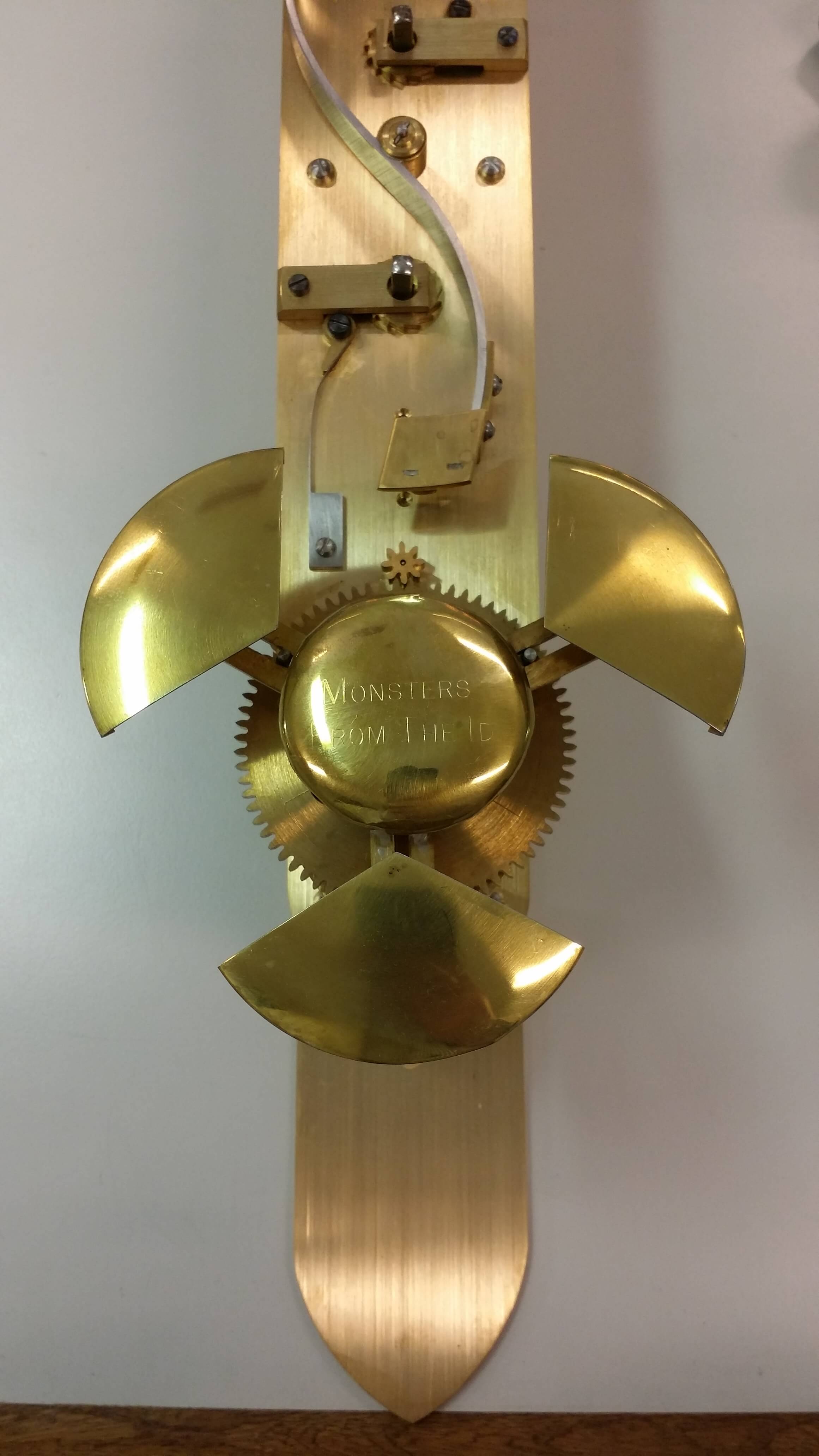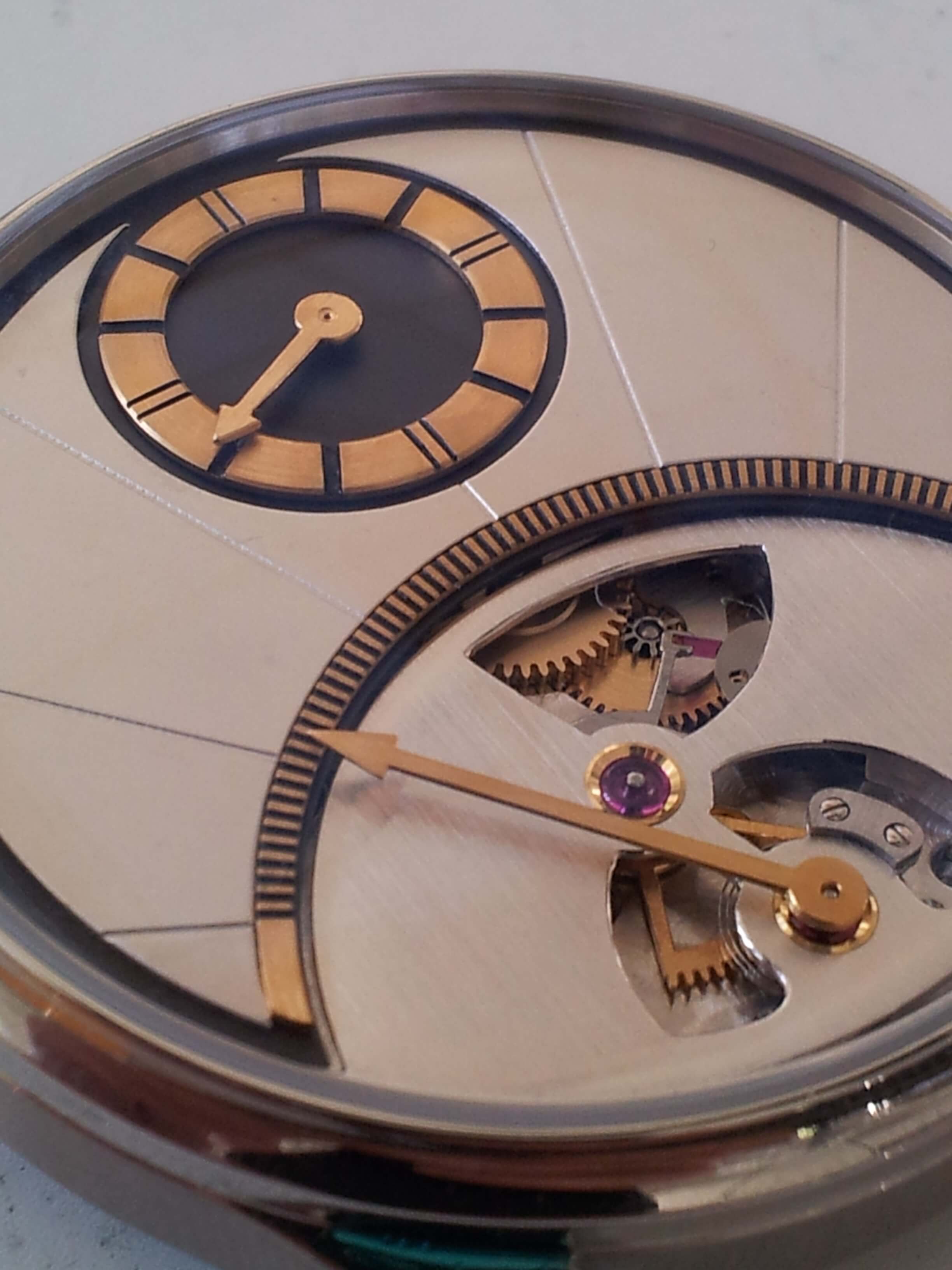Our mission
 Since 2015, F.P.JOURNE's Young Talent Competition supports young watchmaking students and recent graduates to gain a foothold in the world of independent watchmaking.
Since 2015, F.P.JOURNE's Young Talent Competition supports young watchmaking students and recent graduates to gain a foothold in the world of independent watchmaking.
It is organized with the support of The Hour Glass, luxury watch retailer in the Asia Pacific region.
We know the challenges faced by any aspiring watchmaker and our goal is to reward talent, making it known across the world and put their work under the spotlight.
The winner will be presented to the international press in April 2026. Additionally, the winner will win CHF 50’000.- to purchase watchmaking tools and finance his/her horological project.
How to participate?
- Candidates must be between 18 and 30 years of age at the time of registration
- Be watchmaking apprentice or have already graduated
- Self-taught applicants are also welcome
- Applicants must have independently designed and created a timepiece or an horological construction
- Applicants meeting the previous requirements and who participated in previous editions but did not win, are allowed to submit a new creation (one creation per year)
The winners will be rated using 4 criteria:
- Most original concept
- Highest technical complexity
- Most beautiful design and elaborate finishing
- Quality of craftsmanship
What to submit?
- Submit pictures of the timepiece or horological construction
- Include a detailed description, the technical characteristics and dimensions of the timepiece or horological construction
Dates
- July 2025, Registration is open for the Young Talent Competition 2026
- February 2026, Registration closing
- March 2026, Selection of the winner by the Jury
- April 2026, Announcement of the result to the winner
- April 2026, Presentation of the winner during the F.P.Journe Salon
The Jury
The Jury of the Young Talent Competition is composed of key personalities from the international horological scene:
- François-Paul Journe, Watchmaker constructor
- Philippe Dufour, Watchmaker constructor
- Andreas Strehler, Watchmaker constructor
- Giulio Papi, Watchmaker constructor
- Marc Jenni, Watchmaker constructor
- Michael Tay, The Hour Glass Singapore
- Elizabeth Doerr, Watch Journalist
The winner of the Young Talent Competition will:
- Be presented during the F.P.Journe Salon
- Get a CHF 50’000.- grant from The Hour Glass and F.P.Journe to invest in watchmaking tools and finance an horological project
- Receive a diploma signed by François-Paul Journe and the other members of the Jury
“It is not easy for youngsters to start. I was lucky to work at my uncle’s atelier when I was young and received the support of passionate horological actors. It is my turn to help them a little as I was helped at a young age.”
François-Paul Journe is the only three-time winner of the Aiguille d'Or grand prize from the Fondation du Grand Prix d'Horlogerie de Genève and one of the most recognized independent haute horology watch constructor in the world.
Winners
Alexis Fruhauff
Pendule à Seconde
29 years old - Paris - France
Graduate of Lycée Diderot, Paris, France - June 2022
Introduction_
This project was born in 2022 during my final year of DNMADe (National Diploma of Arts and Design Crafts) at the Paris watchmaking school, where I discovered high-quality masterworks made by students in the late 19th century. After graduating, I refined and enhanced the project by incorporating inspiration from the work of French watchmaker Antide Janvier, whose atypical and distinctive creations I particularly admire.
Design and Crafting_
The Pendule à Seconde was conceived from a blank page: no component was reused from a previous project, and even the tools themselves were entirely designed and manufactured to create the various parts. The work extended over a three-year period, in parallel with my training.
The regulator was built in a traditional way, mixing modern and classical techniques: hand-filing, turning on a Schaublin 102 and an 8 mm watchmaker's lathe, milling on an Aciera F3, and machining on a Hauser 2BA jig borer. All components are removable, making maintenance, transmission, or later decoration easier.
Horological Architecture_
The movement, suspended on a bracket, operates with a pivoted detent escapement with lost beat, inspired by the work of French watchmaker Paul Garnier, combining teeth and pins. Only the right pallet delivers the impulse; an opposing pallet ensures safety. The pins are machined from a modern alloy, Hardiall®, which is self-lubricating, lightweight, and highly wear-resistant.
The balance wheel, mounted on an Invar stem, is removable. It features a system of screw-in lenses and a fine-pitch dead point adjustment, allowing for extremely precise regulation.
Power is supplied by two symmetrical barrels with Maltese Cross stopworks, echoing the philosophy of Breguet’s marine chronometers, avoiding the fusee-and-chain mechanism and delivering constant force required for a detent escapement. Each barrel includes a screwed cover with isostatic repositioning, an external hook, and hardened steel shafts, ensuring perfect concentricity and controlled wear.
The gear train was entirely hand-crafted. The pinions are cut, hardened, blued, polished with boxwood, then turned "between centers" to guarantee concentricity. Lateral oil sinks and choked conical pivots help retain oil. The wheels, screwed to the arbors, are oversized like in school calibres, enabling future repairs or decorative finishes.
The ratchets and click springs were slightly redesigned for greater comfort during unwinding, while preserving the "school" spirit. Their surfaces are softened and undersides hollowed out to prevent plate abrasion.
Case and Dial_
Two options were explored for the case: one in gilded bronze, and one in solid cherrywood, which was ultimately chosen. Inspired by the clock cases crafted by cabinetmaker Jean-Ferdinand Schwerdfeger for Antide Janvier, it was designed after graduation with the help of Stéphane Girardot – a Parisian antique dealer specialising in historic horology – to respect the proper proportions of late 18th-century French clockmaking. The whole case can be disassembled into three parts (base, frame, hood) and includes a secret door.
The dial, hand-engraved and silvered brass, is mounted via an invisible fixing system - a genuine technical challenge. It is accompanied by a hand-engraved amplitude measurement plate for the balance wheel, allowing precise visualisation of the pendulum’s motion.
Technical Specifications_
Dimensions: 55 × 32 × 23 cm
Weight: approx. 7 kg
Escapement: pivoted detent with lost beat, steel and Hardiall® pallets
Balance wheel: Invar stem, screw-in lenses, fine metric thread adjustment
Barrels: double Maltese Cross barrels, screwed covers, hardened steel shafts
Pinions: boxwood polishing, blued, hand-cut and finished
Wheels: oversized thickness, screwed
Ratchets and clicks: redesigned, hollowed, hand-machined
Case: solid cherrywood, disassemblable, secret door
Dial: hand-engraved silvered brass, invisible mounting
Finishing: traditional hand-finishing, Schaublin 102, Aciera F3, Hauser 2BA
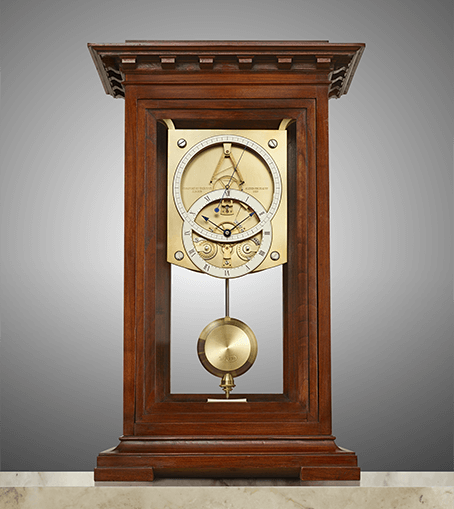

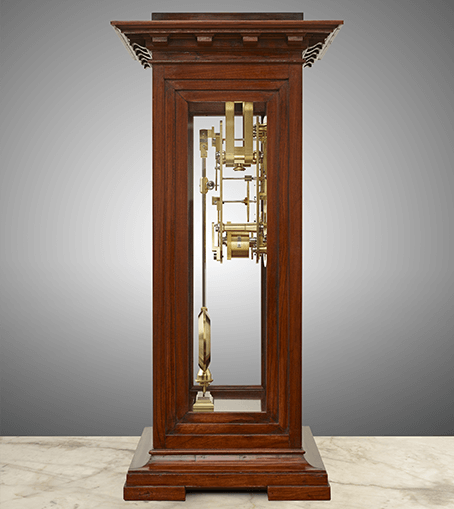
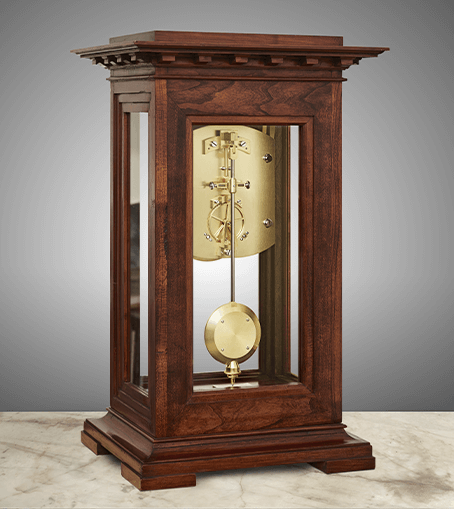
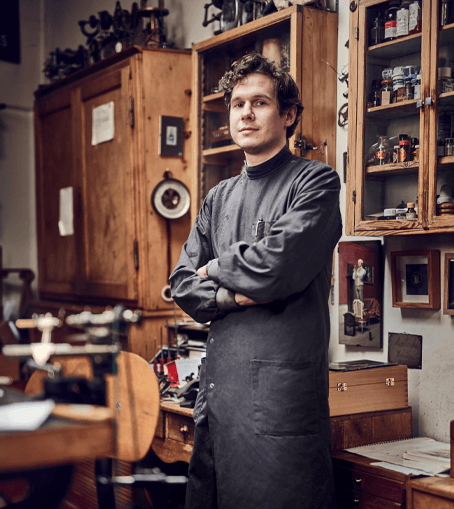
Thomas Aubert
Séléné
23 years old - Le Russey - France
Graduated from Edgar Faure High School in Morteau, France - July 2023
Introduction_
During my final year at Edgar Faure High School, I was fortunate enough to be able to make a timepiece I called Séléné. The project required us to think creatively in order to design, produce, and assemble our watch. That year my class was lucky enough to be assisted by John-Mikaël Flaux, a French horological designer who specializes in automata. Mr. Flaux gave us a great deal of freedom. The only constraints were that we choose a base movement and that we create a non-dragging animation. One of the requirements imposed by the training program was that our creative process had to be centred on a specific theme. I decided to concentrate on curiosity, a feeling that the mechanical arts have always aroused in me.
The origin of the project’s aesthetic style_
This watch was entirely designed and produced between October 2022 and June 2023. During the first month I spent a lot of time learning things, both in the field of horology and in other completely different areas. While pondering and learning, I came to be interested in astronomy. It seemed to me that this was a vast and fascinating subject, and it elicited the curiosity of many people. One thing led to another, and I began to investigate shooting stars. That phenomenon is intriguing and accessible to everyone. By the way, do you know why we make a wish when we see a shooting star? According to the Greek astronomer Ptolemy, when the gods came to watch over humans, they pushed the stars to one side – this was a manifestation of their curiosity about mankind. Thus, shooting stars represent a way of contacting the gods, so that they remain close to us and make our wishes come true. When I heard that anecdote, I realized it would make sense to create a watch with animated shooting stars as a way of representing curiosity.
From an aesthetic point of view, I wanted my watch to reflect the stars and astronomy and chose to do so by creating contrast and brilliance. The greatest challenge during the design phase was to keep my objective in mind: to make an animated watch with a contemporary design.
I chose to call the watch “Séléné”. That is the name of the moon goddess, who rides through the night sky in a silver chariot drawn by two horses. Her name is synonymous with purity and bright, shining light.
Functioning principle and technical choices_
One of our requirements was to base our work on an existing movement. I chose to modify the entire system, including a key winding movement as a way of paying homage to automata. So I based my work on the gear train of a calibre 6497 and completely redesigned all the other components: bridges, plate, balance, time adjustment and winding, in order to achieve the design I wanted without making any compromises. To give meaning to the concepts of curiosity and shooting stars, I wanted the animation to be rapid, located on the back of the watch, and to be active during winding, so as to maintain the viewer’s interest while the key winding is taking place.
To furnish the driving force for the stars I didn’t want to use a second barrel, as one sees in certain animations, for that would require more space and would also involve other constraints. To avoid this, I developed a system that makes use of the “lost” energy of the click. Normally, the click has a recoil to avoid over-winding of the barrel.
However the energy from that recoil is dispersed and lost. If it is augmented, it can be recovered and redistributed elsewhere. My system is based on the principle of re-using that force in a multiplying gear train.
Thus the shooting stars move due to the principle of cams and feelers at the gear train’s extremity. Concerning time adjustment and winding, these are fairly tradi tional technical choices with a set-hands arbor that allows uncoupling for time adjustment and is fitted on the barrel arbor for winding.
Execution and production_
Execution began after the conception and design phases, around the month of January. This was the step I was the most confident about. I trained with Luc Mon net (a French clockmaker who specializes in the mechanical arts) and I had some machines at home. I made almost everything except the glasses and the strap.
Components such as the bridges and the plate were produced on a Hauser jig boring machine and a Schaublin 102 lathe. Each hole was reamed on the jig boring machine, in order to achieve perfectly concentric jewels. I used numerical controls for more technical milled pieces such as the dials and the case. The greatest difficulty I encountered during production was when piercing the back glass. It took me over 2 weeks to discover the correct technique on a traditional machine, so that the glass was pierced cleanly and without any chipping.
All the chamfering was done by hand with a file; the pieces were then polished with diamond paste, as were all the block-polished pieces. The steps of prototyping and starting the mechanism took a great deal of time, because they involved both correcting pieces and dealing with many unforeseen situations. After decoration, all the components were assembled. This was approximately one week before the project’s due date, in June.
Presentation and description of the watch_
Séléné is a mechanical watch with two hands and a 46-hour power reserve. Its 316L stainless steel case is 43 mm in diameter, 13 mm high (with glass) and weighs 110 g. Its integral strap is unusual in that it has no lugs, which gives it an elongated look and an aerodynamic style that is reminiscent of a rocket ship. A rubber strap was chosen to give a sporty look, and because it is a material that offers many options in terms of both colour and style.
The shooting stars on the watch back move during winding, as the key is turned. Made of steel, they are block-polished and chamfered to give them “shine”. The dial they are placed on is made of sand-blasted blued steel.
The constellation of Pisces is engraved on the watch; however, this may be adapted to suit the client’s wishes. On the front, the dial is made up of two parts: the interior, in silver, has a scratched finish and a circular-grained outer portion. The indexes are steel balls, echoing the stars.
The hands are made of steel. They are chamfered, blued, and polished, and their surface is block-polished to create contrast. The three-quarter bridge and the plate are made of nickel silver with a sand-blasted and scratched finish. The pallet bridge is made of sand-blasted and chamfered steel. The entire surface of the balance cock is block-polished, and it is chamfered.
Conclusion_
I am proud of this project, for aside from the horological object per se, it represents a key moment of my life. All my energy, all my skills, and all my knowledge were devoted to it during its creation. This project allowed me to acquire new skills and knowledge, and to accept challenges that were both mental and physical.
I would particularly like to mention the incredible telephone conversations I had with Luc Monnet and Théo Auffret (winner of the Young Talent Competition 2018), who generously and enthusiastically gave their time and shared their knowledge, purely due to their passion for horology and their desire to help me with my watch.
In conclusion, this year was one of increased and deepened self-knowledge. In order to successfully complete the project, I spent many long moments at my workbench, thinking. Those moments allowed me to realize how much I enjoy making horological projects come into existence, whether by creating my own pieces, or, on a more modest scale, taking part in the projects of others. This experience has strengthened my desire to devote myself to creation and design after finishing my studies. Until I have enough time and money to produce my own creations, I have founded my own micro-entreprise specialized in making prototypes and components.
Technical specifications_
Diameter: 43 mm / Thickness: 13 mm / Weight: 110 g / Calibre: 6497 modified (creation of bridges, plate, balance, time-setting and winding systems) / Case: 316L stainless steel / Finishing: traditional, hand-decorated.
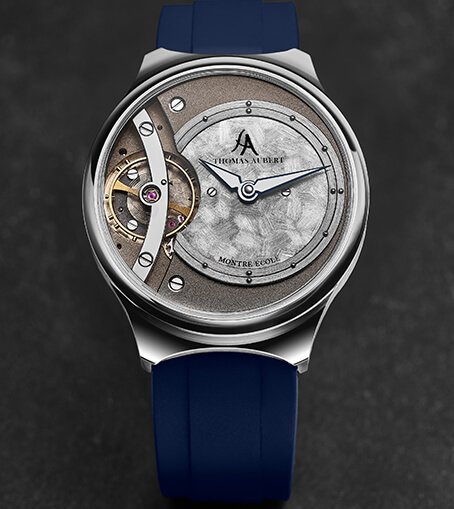

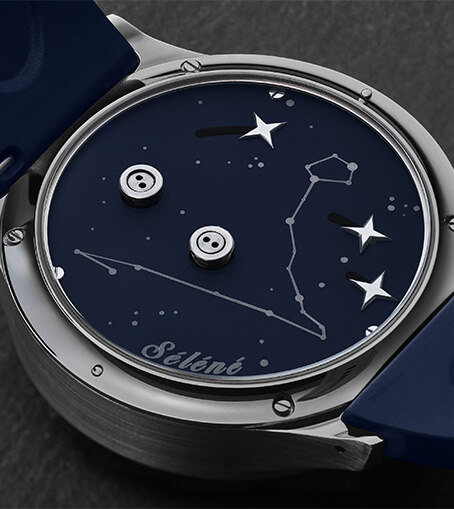
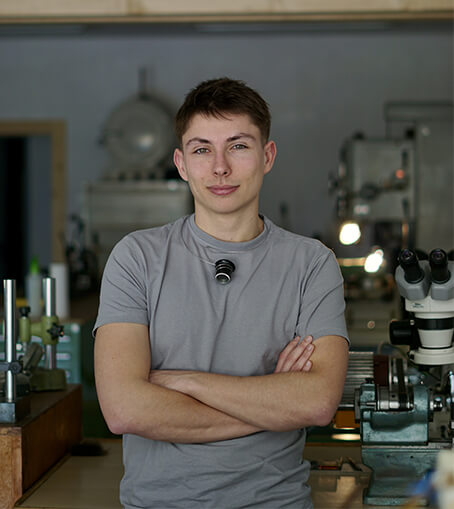
Alexandre Hazemann
AH.02 Signature
Age 23 - Pontarlier - France
Graduated from Lycée Edgar Faure in Morteau, France - July 2022
Introduction_
For the 7th year of watchmaking studies at the Lycée Edgar Faure in Morteau, we are asked to create a school watch with a striking mechanism at the passage of the hours with a display of the hour in instantaneous jump. This project was realised in collaboration with my long-time friend Victor Monnin. We share a philosophy, a “mindset” similar to that of two brothers. Moreover, our skills complemented each other perfectly. Victor is more involved in project management and organisation, as well as in the machining of components. As for me, I have more facility for the watchmaking construction, the watchmaking calculations which ensue from it as well as the prototyping.
Realisation of the project_
This adventure took place from October 4, 2021 to June 10, 2022. Chronologically, we started by making sketches including the design of the watches from October to November. We then moved on to computer design and watchmaking calculations from December to January. Then, we manufactured all the components during 2 months, from February to the end of March. I should specify that we made all the parts except for the glass, the bracelet and the basic movement. The components were manufactured with traditional machines (milling machines, pointing machines...) but also with CNC. The movement LJP6900 was delivered in trays, with only the various pointings and millings carried out. We then had to finish cutting the bridges and the plate. The following month was reserved for prototyping and reliability. The goal was to find and solve the problems one by one in order to obtain a functional watch, capable of keeping time with impeccable precision. We then made the entire stainless steel case on a traditional machine to accommodate the double complication movement. May was reserved for the finishing. I made the satin finishing of the bridge and of the faces with a cabron, the sandblasting of the plate... Finally, I had to find the suppliers to make the electroplating (Ruthenium anthracite). To end, I made the final assembly to have the watch finished and functional for the beginning of June. It took us almost 8 months and more than 1,200 hours of work to complete our project in its entirety.
How it works_
A striking hour function differs significantly from a quarter repeater. Moreover, considering the synchronisation of the mechanisms, it is necessary to explain the principle of the instantaneous jumping hour. A striking hour emits one sound per hour. We have chosen to link the jump of the hammer to the jump of the hour. To do this, we used a lever that performs 3 actions for the same cycle. The first action is to constantly stay in contact with the hour cam in the center of the movement. Then, for the jump of the hours, a finger fixed on the lever drives the star wheel when the lever falls on the cam. Finally, for the third action, the lever arms the hammer in its ascending arc and then releases it when the cam jumps to let it strike with all its inertia against the gong. We have also developed a unidirectional time setting system which allows the rotation of the cam in one direction only, which makes it impossible to break it. A retractable pinion is installed between the timer and the first time setting gear. In the event that the user corrects the time in the wrong direction, the pinion will retract and rotate freely.
Technical specifications_
Diameter: 42 mm / Height: 12.8 mm / Weight: 120 g / Caliber: LJP6900 re-worked / Automatic movement / Unidirectional time setting / Fully manufactured complications / Striking hour - Instantaneous jumping hour / Power reserve: 50 hours / 14.8 lines - 34 jewels - Frequency: 28,800 V/h Case: Stainless steel - Water-resistant to 3 ATM / Custom made sapphire crystal - Swiss made / Bespoke blue alligator strap Finishing: All parts are decorated by hand, hand beveled, additional plate in nickel silver, grained and laser engraved, laser engraved and hand varnished dials, brushed case, polished bezel, laser engraved and sandblasted back.
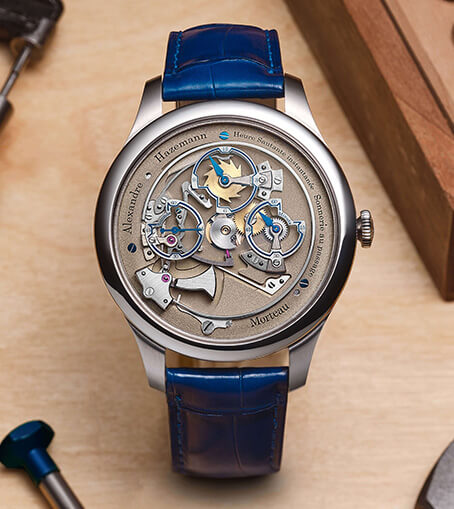

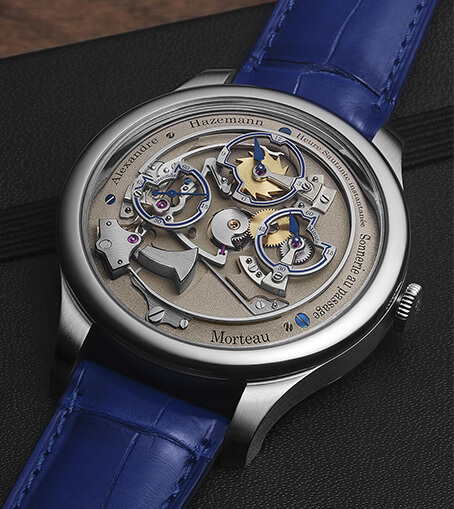
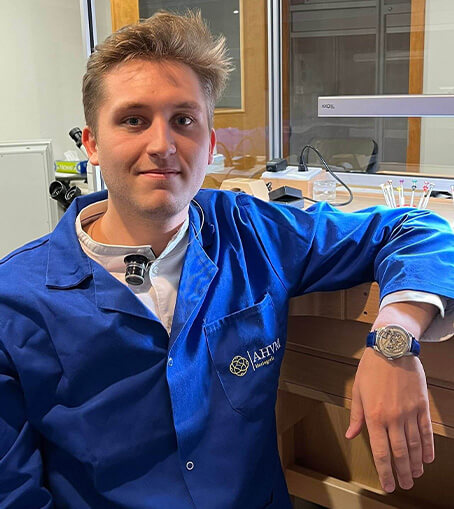
Maciej Miśnik
Marine design pocket watch with tourbillon and pivoted detent escapement
Age 30 - Warsaw - Poland
Self-taught - Journeyman's certificate in watchmaking - Warsaw, June 2018
Graduate in physics - Gdańsk University of Technology - September 2021
Case, hands and dial_ Marine chronometers inspired the presented pocket watch. For this reason, the case was made of brass, however, for contrast, the pendant and the bow were made of silver. Most parts were made in my own workshop without using CNC machines. Basic machines such as lathes, milling machines and hand tools were used to make the watch. For readability, steel hands were thermally oxidized to blue. In my opinion, blued hands harmonize with black indexes on the silver dial. For added complexity, the hour hand jumps once per hour rather than smoothly, as is the case with most watches.
Technical characteristics of the movement_ As in marine deck chronometers, a pivoted detent escapement was used. Oscillation frequency of the balance wheel is 2 Hz. It is well known that detent escapement has good friction properties but it is not shock resistant. Due to this, I decided to make a pocket watch instead of a wristwatch. Additionally, the watch was equipped with a tourbillon thereby reducing the problem of poising the balance. Two barrels are used to ensure sufficient torque. A major problem with watches using a tourbillon is the inertia of the cage. For this reason, the tourbillon cage components are very thin and delicate to reduce the inertia. The cage is very heavy, weighing 2 grams, but the problem of inertia was reduced. In the escape wheel, the pinion and the wheel are separated and connected via a bronze hairspring. There is a sleeve with two rubies in the wheel, which runs on the steel axle of the pinion. The hairspring is arranged in such a way that it holds the wheel on the pinion (the wheel does not fall out). As soon as the cage is stationary, the escapement wheel is released. The escapement wheel moves and the cage begins to rotate. When the escapement wheel stops on the ruby, the cage continues to move and winds up the hairspring, losing its kinetic energy, and then slightly backs up. The backing up of the cage results from its high inertia and the reaction force of the hairspring. In most tourbillon watches, the cage stops with the escapement wheel, causing a temporary high force on the escapement elements and undesirable vibrations. In the case of the presented solution, a hairspring absorbs the vibrations, similar to solutions proposed for example by Derek Pratt, Karol Roman etc. The balance wheel is equipped with a Breguet-overcoil spring. There is no regulator on the hairspring due to chronometric properties. Two screws on the balance wheel maintain regulation of the oscillation period. Other screws are used to poise the balance wheel. The tourbillon cage is also poised, by a silver counterweight. Silver was used due to its high density.
Manufacturing of the components_ The presented watch is made of raw metals. No elements have been electro painted or plated. Only the hands and three screws were thermally oxidized to blue. Sulphide was grown on silver elements, this is what gives this darker look to the dial and to the small plate with the signature. As it was written, I made most of the parts myself. Every part was finished by hand. In my workshop were not made: the watch chain, glass, 18 ruby bearings, balance hairspring, 2 mainsprings and 28 of 40 screws. I did not engrave the signature; it was made by a professional engraver.
Measurement_ Diameter: without hinge and lock, 4.9cm / with hinge and lock, 5.2cm - Height: 7.1cm - Depth: without screws, 1.55cm / with screws, 1.67cm - Weight: with key and chain, 112.2g / without key and chain, 100.2g
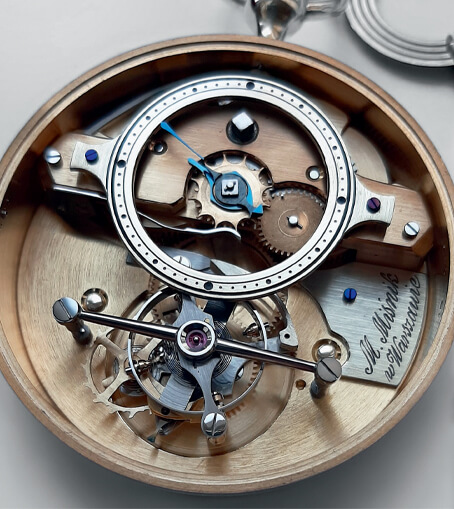

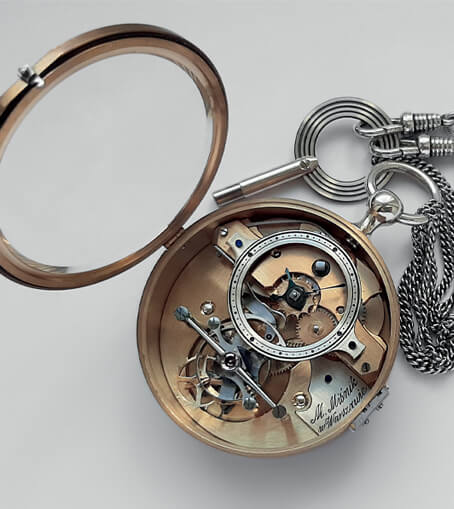
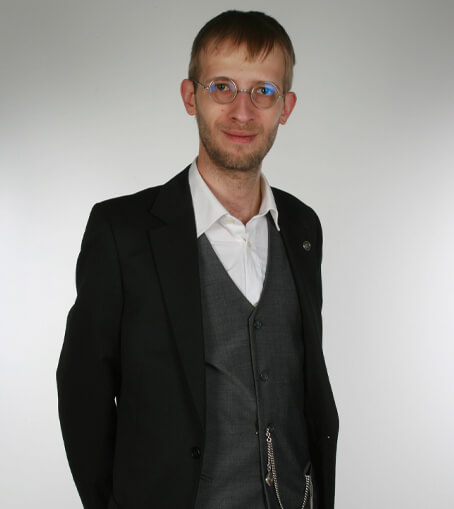
Mario Scarpatetti
Kalender Perpeten - Movement with secular calendar based on his patented invention
Age 29 - Parsonz - Switzerland
Graduate from the Zeit Zentrum Grenchen - July 2012
Introduction_ “The idea for this clock with secular perpetual calendar came up in winter 2016, with a moon ball for the moon phase, and a time equation, wanting the clock movement to have a very long power reserve. The heart of the movement is the perpetual calendar, which automatically corrects even the uneven secular years. Controlled by a wheel that turns once every 400 years, the date needs no correction.
Brief story about the invention of Mario Scarpatetti’s “secular perpetual calendar”_ In 2013, I made a clock with classic perpetual calendar with a 4-year wheel but something bothered me. The mechanics may be leap years recognize between centuries, but not whether a century or millennium is a leap year or not. I started to think about a mechanism that could recognize whether a century or a millennium has a February 29th or not. In 2013, during a train ride, the solution came to me. My idea is to supplement the mechanics of a well-known perpetual calendar with an additional wheel that turns once every 400 years. The greatest achievement is the ease with which this 400-year wheel is switched.
Shortly afterwards, I was asked whether I would make a movement for the drive of a planetarium and I put my sketches in pending. In 2016, I finally found the time to design a clock with my own perpetual calendar. I started milling the first wheels in 2016 and the construction of the large movement lasted until summer 2018. During the production, in March 2018, I applied for a patent for my invention by the Swiss Federal Institute of Intellectual Property relating to a 400-year wheel and its indexing. My 400-year wheel received in 2018 the patent N° CH 00400/18.
Manufacturing of the movement components_ All parts of the movement, with the exception of four ball-bearings (Kugellager), were traditionally handmade. Most of the parts were made from brass and steel sheets, as well as brass and steel round bars. For the manufacturing of the movement, I’ve made all parts without NC and CNC-controlled machines. The movement can be dismantled into 478 individual parts. It consists of a total of 570 components”.
Measurement_ Mechanism: Height: 48 cm - Width: 48 cm Total clock height: 203 cm Total clock weight: 50 kg. Movement: Height 42 cm Dial: Height 41 cm Weight: 21 kg, Sassalbo stone from Poschiavo.
Indications_ Months - moon phases - years / hours - minutes - seconds - equation of time / date - day.
Mario Scarpatetti’s secular perpetual calendar explained in detail_ “All components, such as the rocker switch (Schaltwippe), are exactly the same as in a known perpetual calendar with a 4-year wheel. The 4-year wheel is the first on my calendar that looks different. All 4 deepenings for February have the same depth. The 4-year wheel therefore does not decide whether February has 28 or 29 days. A shift finger (Schaltfinger) is pressed into the front of the 4-year wheel. This finger thus makes one turn every 4 years and switches the 400-year wheel further. The whole thing also works with two shift fingers, as I described in my patent application.
The 400-year wheel had to be manufactured slightly differently. The wheel is switched twice every 4 years, but not regularly every two years. The placement takes place a few months before a leap year (e.g. between April 2019 and January 2020). The next placement takes place after February of a leap year (e.g. between April 2020 and January 2021). The 400-year wheel then remains in the same position for about 3 years. Only then does the next switching take place (in our example between April 2023 and January 2024). The switching is very energy-saving over several months. The shift finger grips in the outer gearing of the 400-year wheel (a fine gearing with 200-teeth). A pawl also grips in the same gearing for positioning.
The inner scope of the wheel has 97 elevations. The nose of the rocker switch of the perpetual calendar feels the 400-year wheel every February. If the nose falls into a gap, the clock switches from February 28 th to March 1st. If the nose rests on one of the 97 elevations, the mechanics switches from February 28 th to February 29 th and then to March 1st the following night.
It gets interesting now at a century or a millennium. In the case of the gear wheel, there is a very large gap at the point where a step would be for three consecutive centuries. At this point, instead of two gaps, the gear wheel has only one gap in the width of three divisions next to a step. Only in the fourth century is there an elevation where the nose feels the century. Namely for those centuries which are a leap year. That is why the 400-year wheel has 97 and not 100 steps inside”.
A small example of the intelligibility_
- In February 2021, the nose of the rocker switch falls into a gap. The clock switches from February 28, 2021 to March 1, 2021.
- In February 2024, the nose of the rocker switch is on one elevation. The clock switches from February 28, 2024 to February 29, 2024.
- In February 2100, the nose of the rocker switch falls in the middle of a wide gap. The clock switches from February 28, 2100 to March 1, 2100.
- In February 2400, the nose of the rocker switch is on one stage. The clock switches from February 28, 2400 to February 29, 2400.
The Gregorian calendar is based on a cycle of 400 years, after one turn of my wheel the game starts all over again, just like with the Gregorian calendar. The owner of the clock never needs to adjust the date.
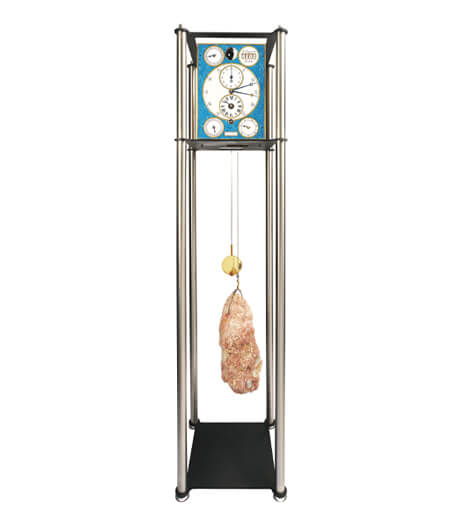

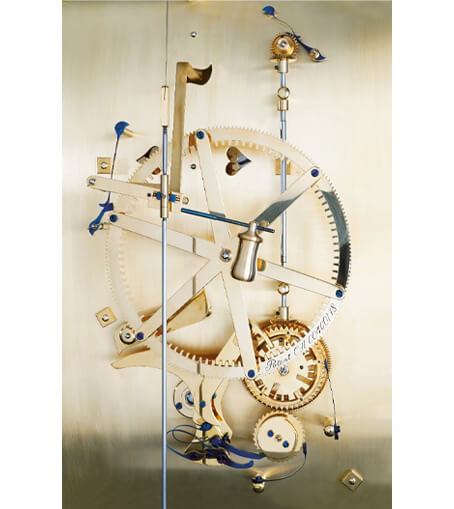
Norifumi Seki
Age 23 - Tokyo - Japan
For his pocket watch Spherical moon and drum calendar
Project_ At my watchmaking school, I attended a course where applicants can make their own watch over a year and I chose to make this watch as a graduation production. I wanted to make this specific complication because I thought it would be interesting to make a watch with a large moon phase for an increased visibility. Since the disk type that is usually used has a large design limitation, I decided to display it as a sphere in order to be more visible.
Challenges_ The problem I was facing was that the vertical calendar display did not work as expected but the moon display worked smoothly. I also had a hard time redesigning and manufacturing the balance wheel. I am still working on improving the quick jump of the calendar. Made entirely of titanium, the moon phase is 20 mm in diameter and set via a recessed pusher in the case band. A third of the sphere is blue heated, while the other two thirds are coated in gold.
Shown in two large windows, each containing two drums for the digits, the calendar is a simple one, with the month in the left window and date on the right; both can be set via the crown. Because the calendar display relies on drums, rather than discs, it is driven by gears perpendicular to the plane of the movement.
Building the movement_ The movement is a mix of parts made from scratch as well as components from tried-and-test calibres. Amongst the parts I made are the base plate, bridges, and mechanisms for the calendar and moon phase. Most of going train, from mainspring to fourth wheel, are taken from the Valjoux 7750, long a favorite base movement for complications because of its robustness and reliable energy delivery. However, the escapement is from the Peseux 7040 because I wanted to run the movement at 3Hz instead of 4Hz to make the balance wheel larger. I then produced the four-armed balance wheel and paired it with a hairspring from the 7750. As a result, the balance bridge still retains the Etachron regulator index of the 7750. The movement is coated in 18K yellow gold, and finished with perlage and Côtes de Genève. Both the balance bridge and escape wheel cock are hand engraved. I also produced all of the external components of the watch. Though it appears to be engine turned, the dial was actually engraved on a lathe, as I did not have access to a rose engine. But the dial colour was achieved the traditional way, having been silver plated using diluted sulfuric acid. The hands were also made from scratch with a combination of heatblued steel and golden brass.
Technical specifications_
Case: 18K yellow golden brass
Width: 4.7 cm
Height: 2.3 cm
Length: 6.3 cm
Total weight: 140 grams.
Crown and bow also in 18K yellow golden brass.
Movement: coated in 18K yellow gold, with perlage and Côtes de Genève decorations, balance bridge and escape wheel cock hand engraved.
Dial: engraved guilloche silver plated.
Moon: 20 mm diameter in titanium partly golden.
Hands: heated blued steel and golden brass.
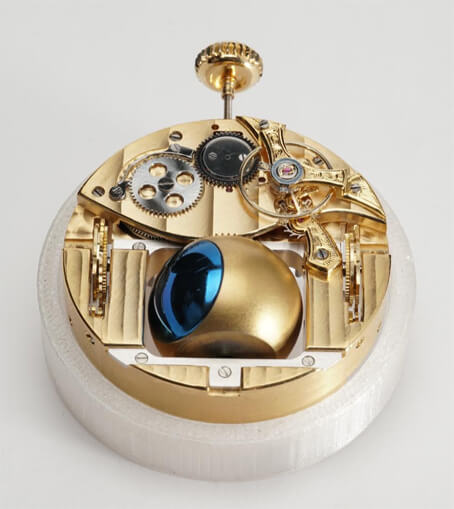

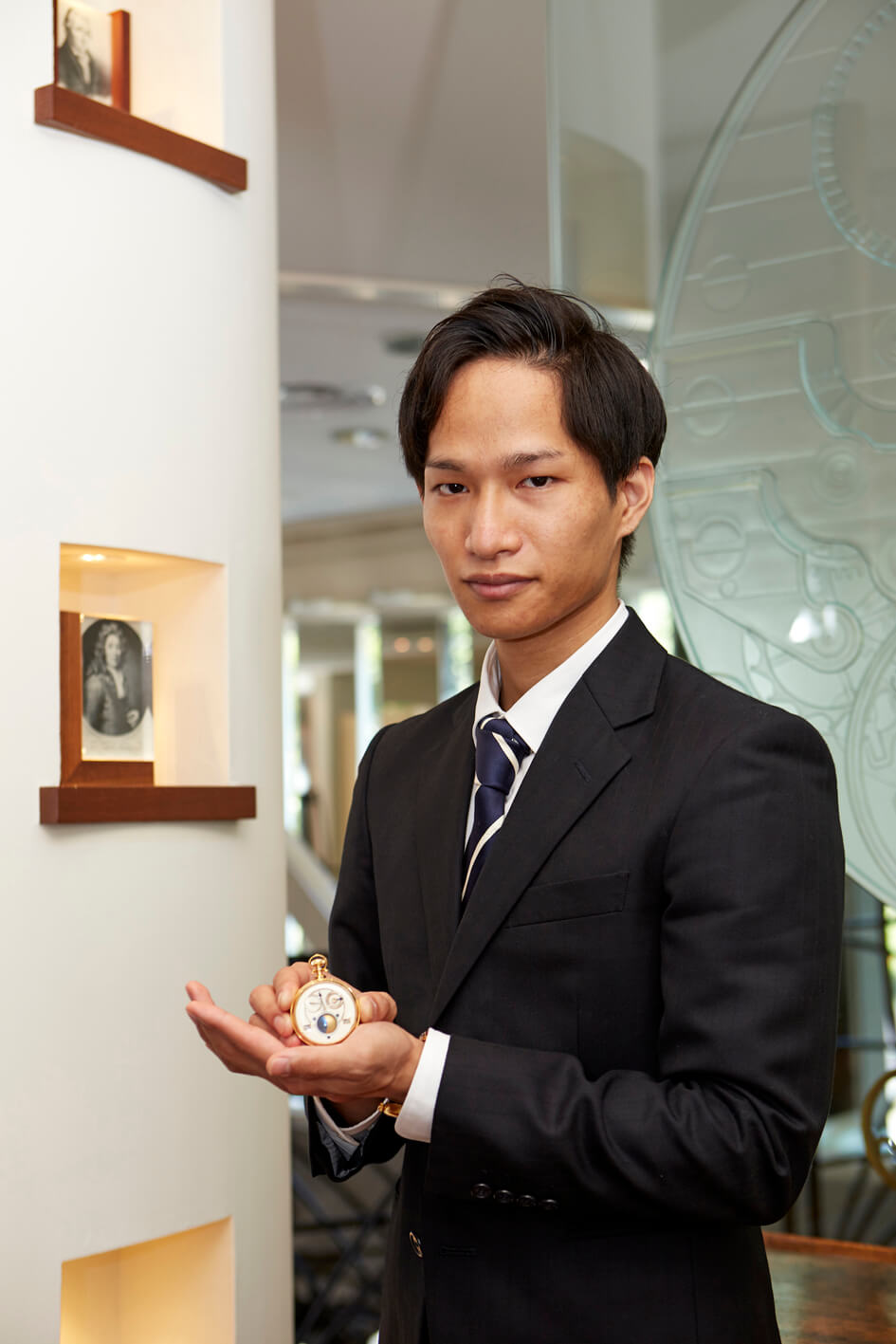
Tyler John Davies
Age 27 - Birmingham - England
For his clock Equilibrium “An expression of the balance between two or more forces”
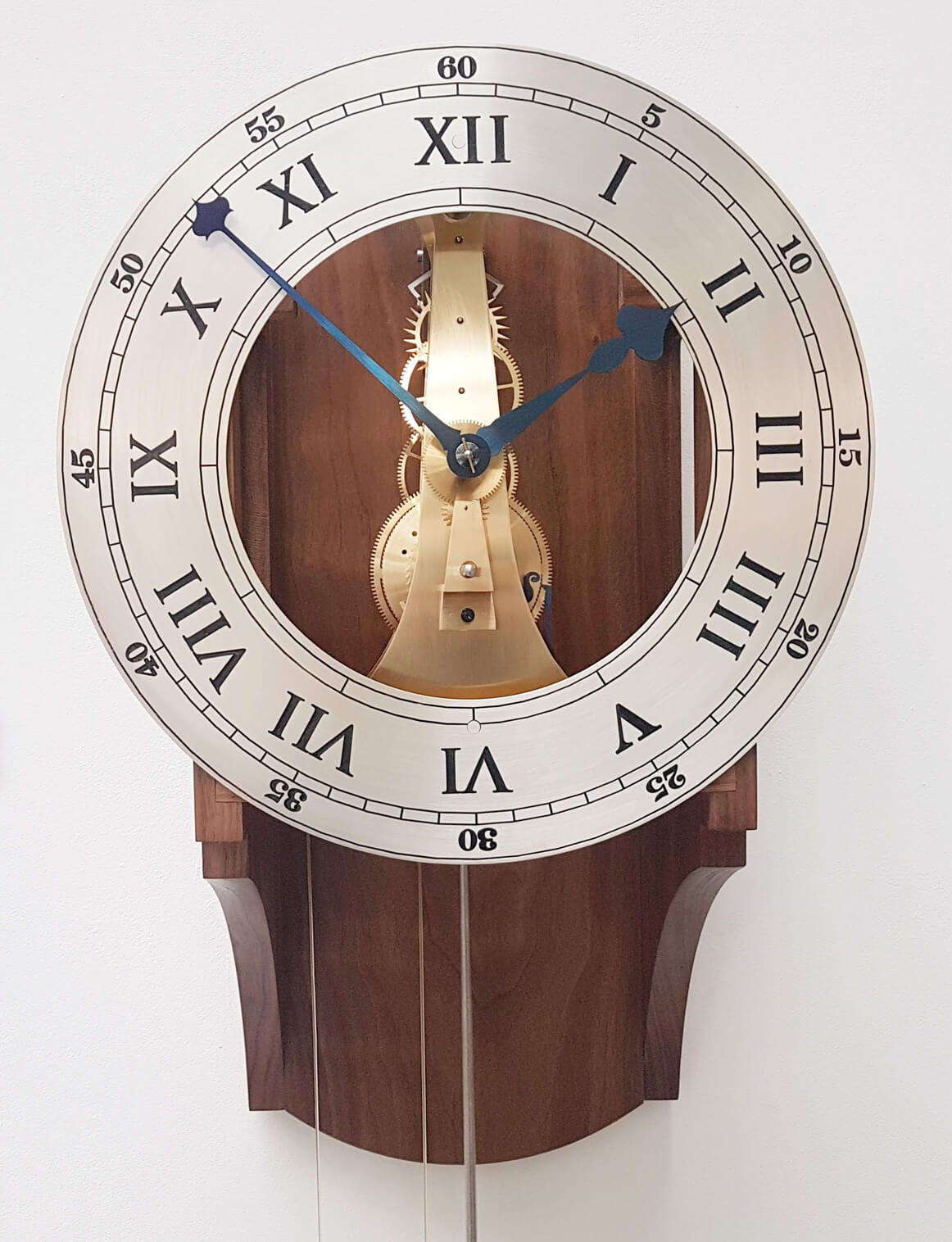


Charles Routhier
Age 24 - Morteau - France
For his wristwatch Halley
Rémy Cools
Age 20 - Morteau - France
For his clock Mechanica Tempus Pendulette Tourbillon
Théo Auffret
Age 22 - Boudry - Switzerland
For his regulator chronometer Tourbillon à Paris
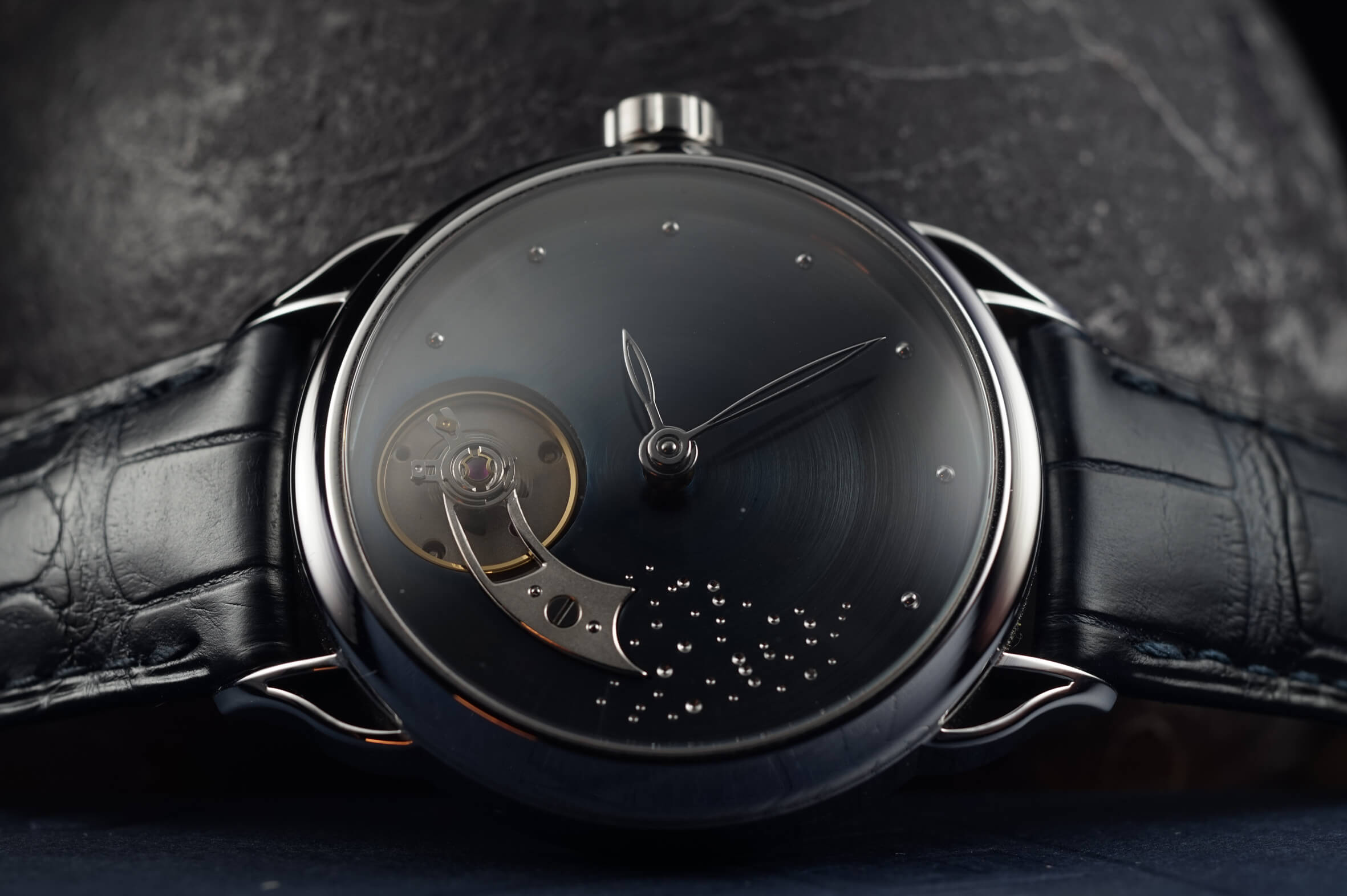


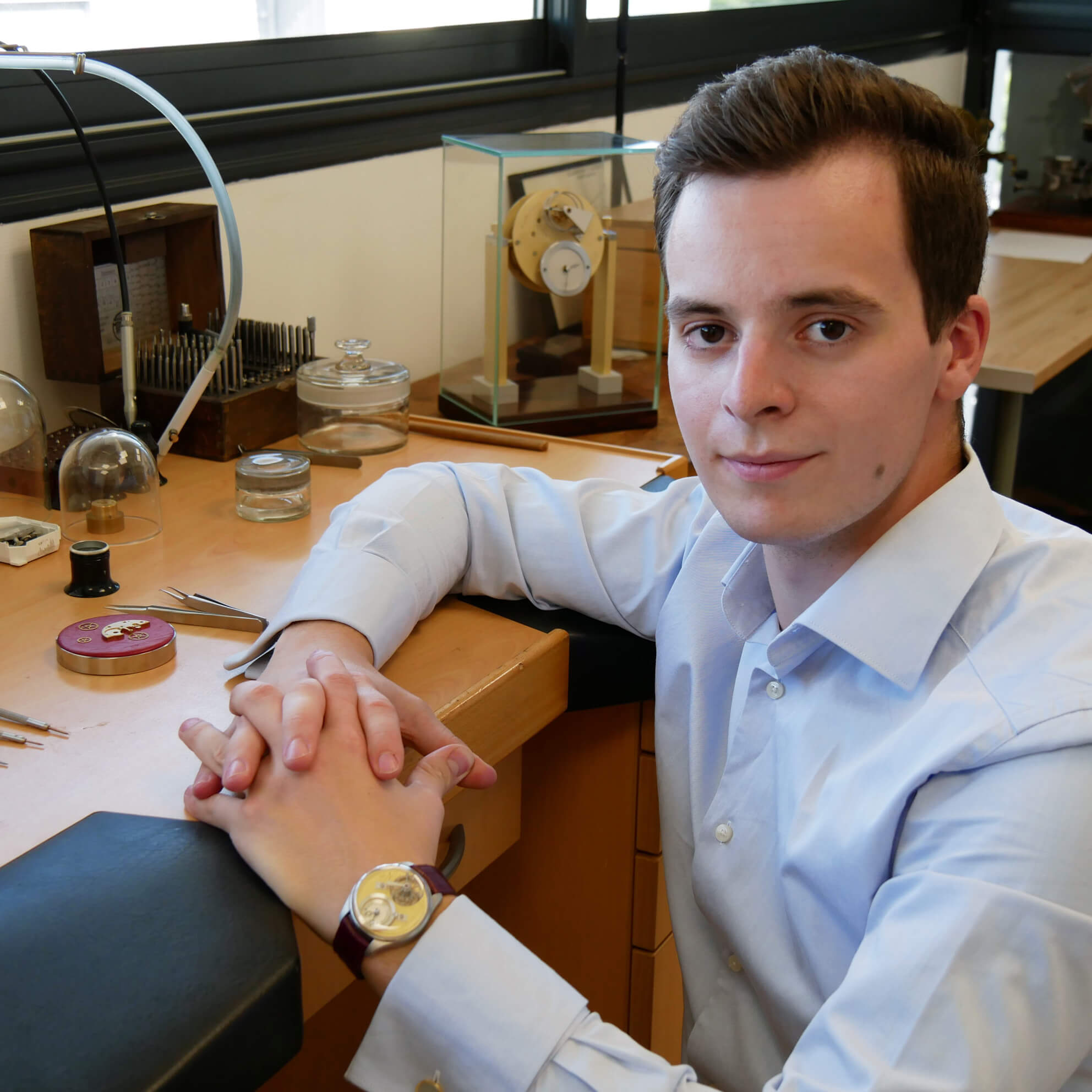
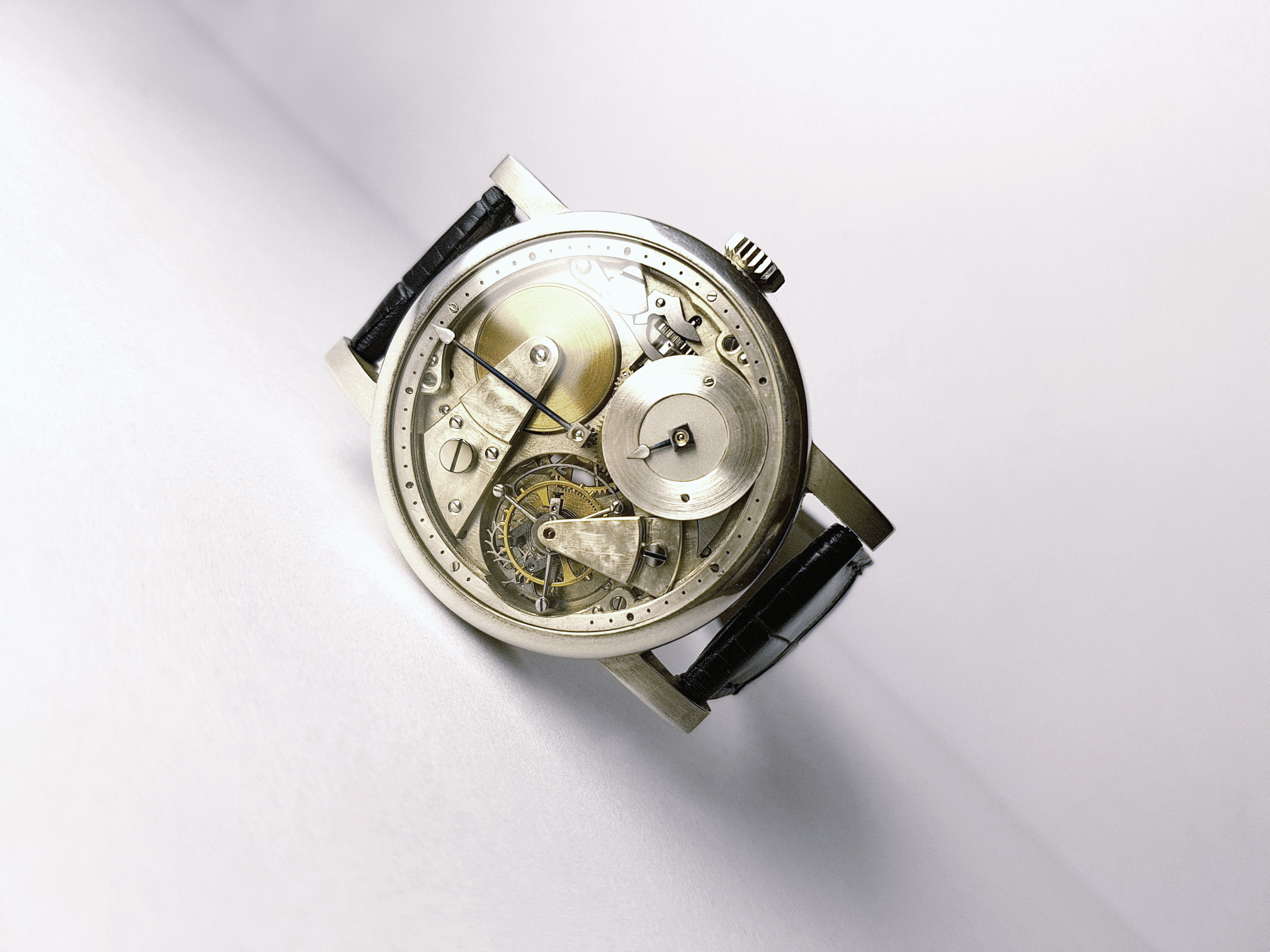

Tristan Ledard
Age 23 - Paris - France
For his Clock with Linear Equation of Time
Anna-Rose Kirk
Age 27 - Birmingham - England
For The Horizon Clock
Anton Suhanov
Age 33 - Moscow - Russia
For his Clock with Triple Axis Tourbillon
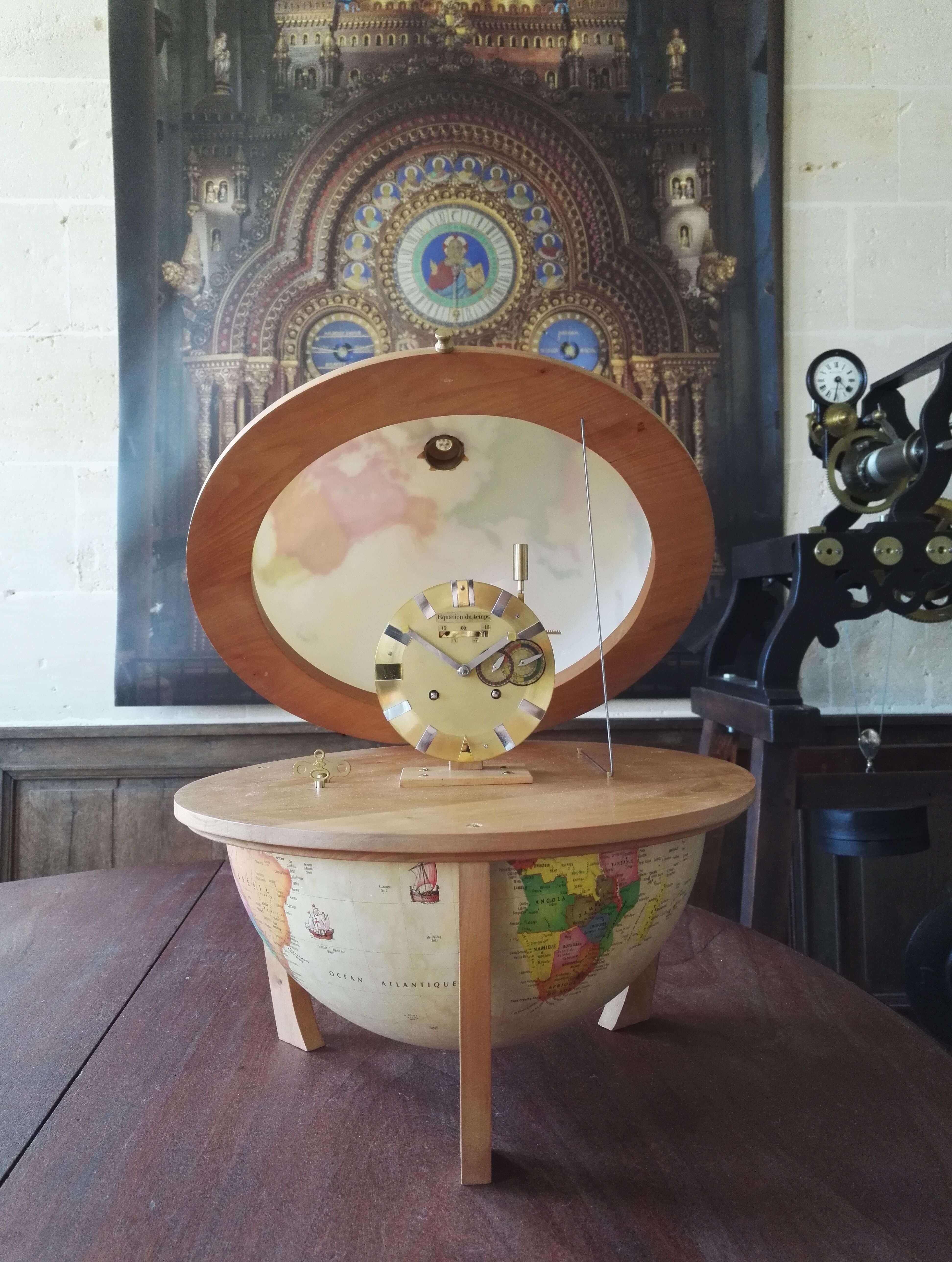

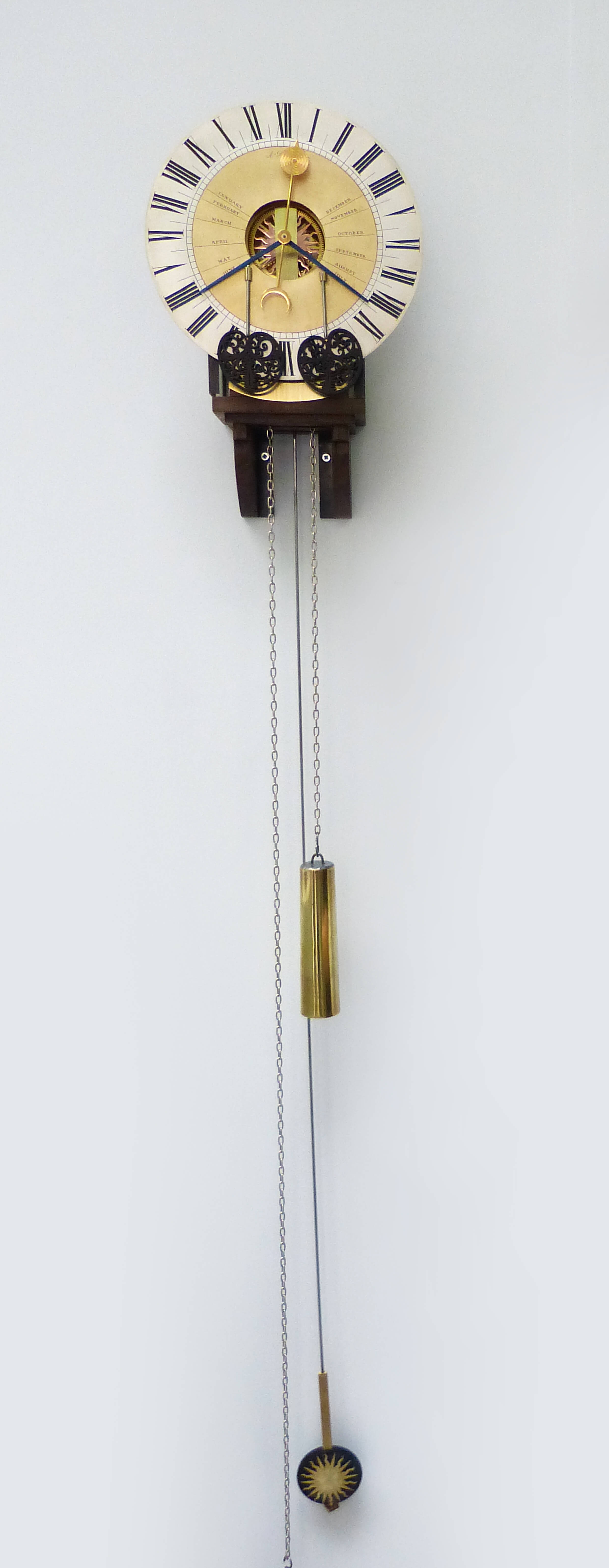
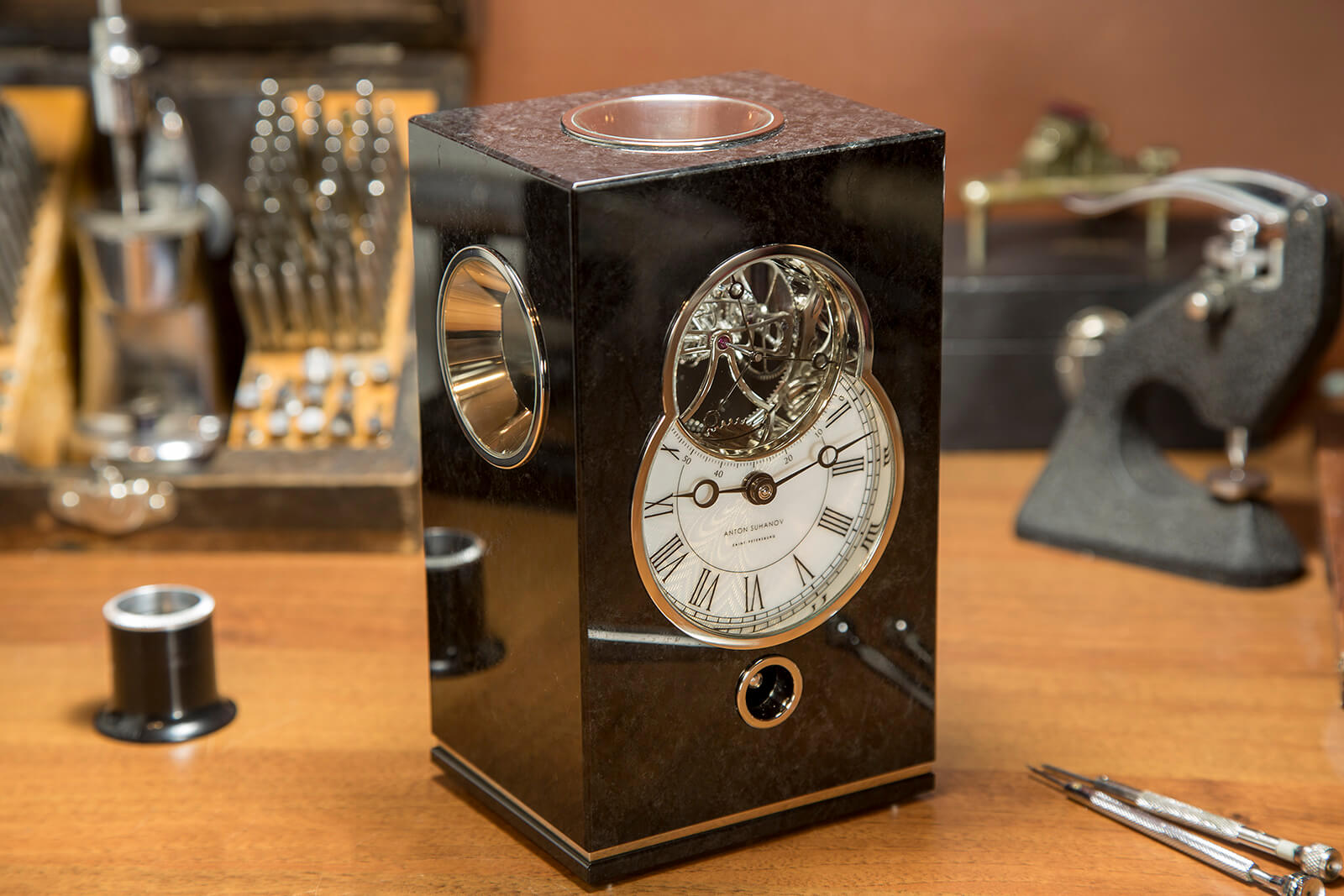
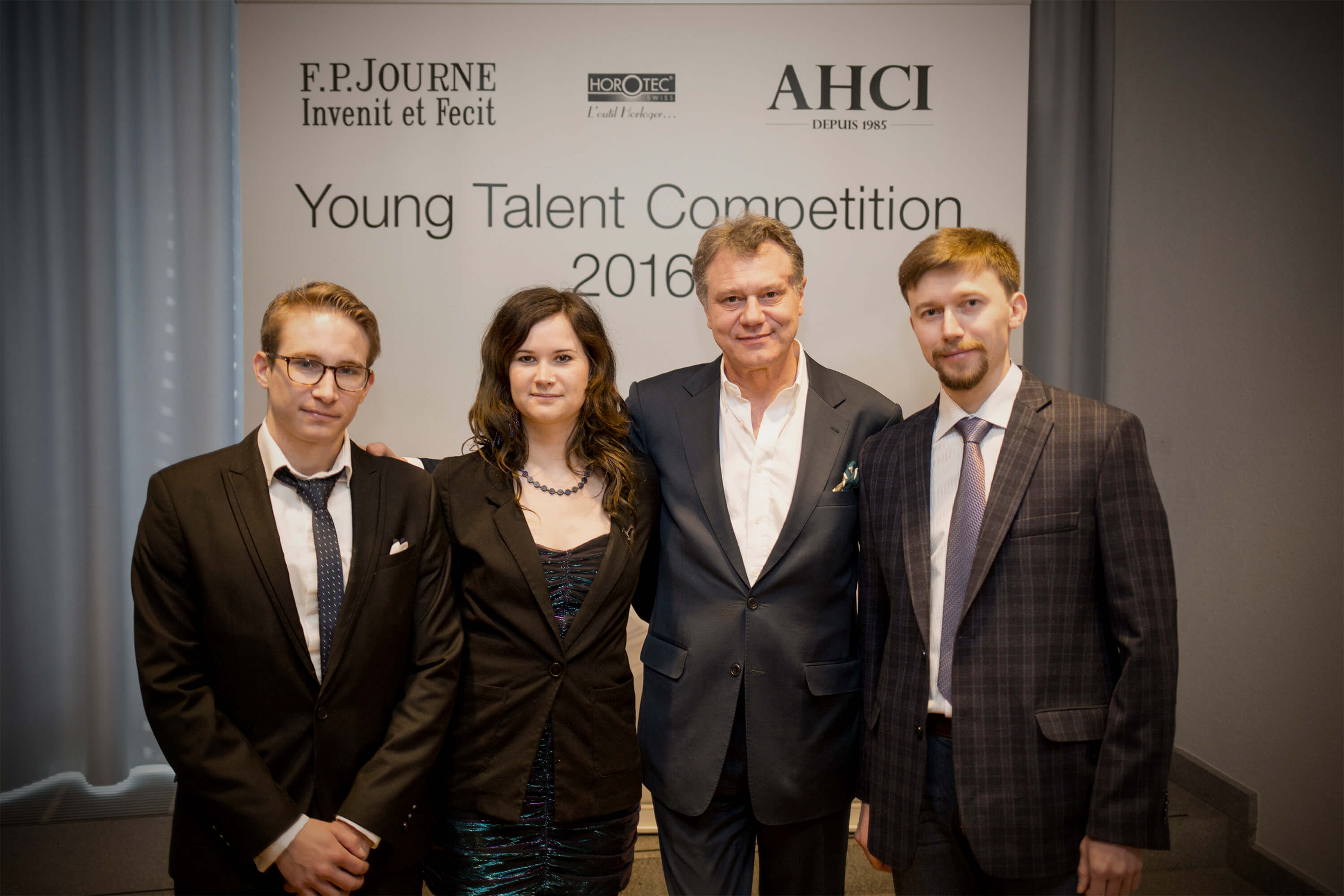
Sebastian Schlette & Pontus Köhler
Motala - Sweden
For their clock Tourbillon Model
Kristian Myren
Ringsted - Danemark
For his clock Monsters from the Id
Alexandre Götze
Kreuzlingen - Switzerland
For his Retrograde Minute Indicator
